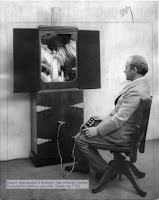 No, it's not another post on Picasso's Light Graffiti, but a nice write up by Trish & Chris Meyer on Thomas Wilfred (left, 1889 - 1968), a pioneer in developing what he called Lumia, or the art of light. They've got specific background on Wilfred, including some movies.
No, it's not another post on Picasso's Light Graffiti, but a nice write up by Trish & Chris Meyer on Thomas Wilfred (left, 1889 - 1968), a pioneer in developing what he called Lumia, or the art of light. They've got specific background on Wilfred, including some movies.The Lumia is in the class of devices called color organs. For some additional details see the AEP's Motion graphics 1961 and Visual music and motion graphics. Here's an excerpt from the latter:
In After Effects, since version 3.1 and the defunct Motion Math, you can synchronize any parameter with any other parameter, so a range of audio effects can be tied to graphic properties to create visual music.
Visual music has a long history in media like color organs, film and abstract animation, light shows, CGI, installation art, and even cave art. Abstract animation is not just eye candy, but often attempts to communicate or stimulate synesthesia or mystical states. While forecasts for an expanded or synaesthetic cinema (PDF) haven't quite come to fruition, motion graphics has. The term seems to have been coined or at least popularized by visual music artist John Whitney, who pioneered motion control cameras and the slit scan technique (showing it to Trumbull and Kubrick) -- and in 1960 named his company Motion Graphics, Inc. SIGGRAPH has a peek at some of his movies.
In addition to the Center for Visual Music, another specific resource for visual music is The iotaCenter. Also noteworthy is the work of William Moritz, who was tireless in documenting early work by abstract animation artists at CalArts and elsewhere and filmmakers like Oscar Fischinger. The Moritz article "Abstract Film and Color Music" in the book The Spiritual In Art: Abstract Painting 1890-1985 (documenting an LA museum show) is quite good. Online, there's a good roundup of color organs and such in Colour and Sound: Visual Music by Maura McDonnell.
No comments:
Post a Comment